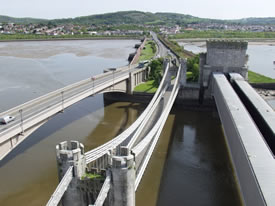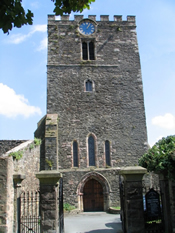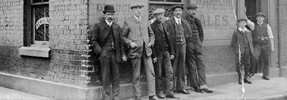The Hollands of Conwy (Conway).
Griffith Pedigree & Searchable Database
A photograph of the Conway Hollands pedigree page contained in Griffith's Pedigree can be seen by clicking on the link here (courtesy of Flintshire Archives). The physical size of the chart is about A3 and can be difficult to navigate visually when looking for a specific name. To assist in locating a specific individual a searchable database and navigable tree have been created.
Griffith's Pedigree has been extended following further research that has drawn upon additional source material including a pedigree compiled by Thomas Erskine Holland in his book "The Conway Hollands" first published in 1893 and held in the National Library of Wales, Aberystwyth.
A fully searchable database of this extended pedigree which includes images of some of the source material used can be accessed by clicking here ![]() . This version will be more convenient for those looking to find a specific person. Click on "Search" or "Surname Index" as appropriate.
. This version will be more convenient for those looking to find a specific person. Click on "Search" or "Surname Index" as appropriate.
An alternative HTML version of this extended pedigree based on Griffith's pedigree can be seen by clicking here ![]() which will open a new page in your browser. Just close that page to return here. To start navigating backwards through the descendants of Peter Holland, just click on his name. For those who are used to browsing with two tabs open you can easily compare the pedigree and html versions by switching between them.
which will open a new page in your browser. Just close that page to return here. To start navigating backwards through the descendants of Peter Holland, just click on his name. For those who are used to browsing with two tabs open you can easily compare the pedigree and html versions by switching between them.
Conway Holland family history
The following notes are based on information contained in “The Holland’s of Lancashire” by Bernard Holland (published 1917).
According to Bernard Holland a branch of the Hollands, were established at Conway in Wales since the late 14th Century. It is believed to have descended from Alan Holland, a son of Robert Holland of Upholland and a brother of Robert, the first Lord Holland, who was beheaded at Henley, in 1328. This Alan is stated to have had a son named John, who was the great-grandfather of Peter, or Piers, Holland of Conway. From this Peter the descent of the family to the present day is shown in the Griffith Pedigree. Peter Holland served in the household of King Henry IV.
The ancestor of these Hollands came, it appears, to Conway, to which English colonists had been brought, in the first instance, by Edward I, after his conquest of the Wales. The incoming Englishmen who came enjoyed considerable privileges over the indigenous population bearing names such as Hookes, Stodart, Acton and Holland.They became the lawyers of Caernarfon, the merchants of Beaumaris, and the gentlemen of Conway.
Besides their town house, called Plas-Issa, the Hollands owned most of Conway and much property in the neighbourhood, in particular Bodlondeb and Marle, holding also the Castle, by tenure of a dish of fish to Lord Hertford when he passed through. The ferry belonged to them, and they are said to have received a large sum in compensation when Conway Bridge (pictured below left) was built. 
In St Mary's Church at Conwy (pictured below right) there are a great many monuments of the family. The inscription on one of these runs as follows; "Edward Holland, Armiger, posuit hoc memoriale Hollandorum ad requisitionem Hugonis Holland, Arm., patris sui, paulo ante obitum, qui obiit 13 die Maii, AD, 1584." The Edward who thus commemorated his father was himself commemorated, on his death in 1601, in another Latin inscription in the same church, by his own son, William. Pictures of all these memorials can be seen here.
This son, William Holland, of Conway, married Catherine, daughter of William Glynn, of Lliar, and with him ended the male succession of this elder line. He had, however, a daughter and heiress, Margaret, who married William Williams. Their son was christened Holland, and his children assumed the surname of Holland, but the male descent of this family again came to an end in the following generation, on the death of Owen Holland, of Plas-Issa, Conway, in 1795. He died without issue, and the property passed eventually to the younger son of his sister Jane, who had also married a Williams, Robert Williams, owner of the charming estate of Pwllycrochon.
This son, the Rev. Hugh Williams, of Conway and Pwllycrochon, left a daughter and heiress, Jane Silence Williams, who, in 1819, married Sir David Erskine, of Cambo, Fife, the great-grandfather of the present baronet of that name.The Welsh property passed by this marriage to the Cambo family, and was sold by them in 1865 for about £212,000.
 Edward Holland, of Conway, who erected the monument in the reign of Elizabeth I, had a younger brother, Robert, who married Joan, daughter of Robert Meylir and of Catherine, heiress of Howell ap Rees Vawr, of Haverfordwest, in the County of Pembroke. Robert Holland was a very strongly Protestant clergyman, M.A., of Jesus College, Cambridge, and Rector of Prendergast, holding afterwards two other Crown livings in Pembrokeshire.
Edward Holland, of Conway, who erected the monument in the reign of Elizabeth I, had a younger brother, Robert, who married Joan, daughter of Robert Meylir and of Catherine, heiress of Howell ap Rees Vawr, of Haverfordwest, in the County of Pembroke. Robert Holland was a very strongly Protestant clergyman, M.A., of Jesus College, Cambridge, and Rector of Prendergast, holding afterwards two other Crown livings in Pembrokeshire.
One of Robert Holland's sons, Nicholas, also took Holy Orders, and in 1618 was presented by the Crown to the Vicarage of Marloes in Pembrokeshire. His descendants, from father to son, for more than a century practiced law at Haverfordwest, holding estates at Walwyns Castle, Walton West, and other places in that county.
It can be seen from the pedigree that the family is no longer represented in Wales, having for nearly two hundred years been settled in England, where they have shown a marked predilection for Oxford and for taking Holy Orders, first in the person of the Rev. Nicholas Holland, M.A., born in 1713, Vicar of Mucking and Rector of Stifford, in Essex. He married Jane Clarke of the Ikenham family.
His elder sons, Thomas, a Colonel in the Indian Army, and William, an Indian merchant, left no male issue. Not so his third son, Dr. Samuel Holland, a distinguished cleric who, besides holding two or three other livings, was Rector of Poynings in Sussex, and after 1817 Precentor and Prebendary of Chichester Cathedral.
Dr. Holland married Frances, daughter of Lord Chancellor Erskine, and had two sons, who both became clergymen, and four daughters. In 1846 he resigned the living of Poynings, in which he was succeeded by his eldest son, Thomas Agar Holland, M.A., previously Rector of Greatham, Hants, who held it till his death in 1888. A short account of him is given in the I Dictionary of National Biography.' He wrote much verse throughout his life, and one of his earlier poems, ` Dryburgh Abbey,' was warmly praised by Sir Walter Scott. He also published prose writings. He married Madalena, daughter of Major Philip Stewart, and had five sons, three of whom became clergymen, as have also two of his grandsons. His eldest son, the distinguished international jurist, Sir Thomas Erskine Holland, K.C., D.C.L., F.B.A., Fellow of All Souls College, sometime Chichele Professor of International Law at Oxford, has several sons, one of them holding a high position in the Indian Civil Service.
Copyright Paul Holland © 2006 - 2022 All rights reserved. Permission is granted for all free personal and non-commercial uses. Sources are available on request. |


